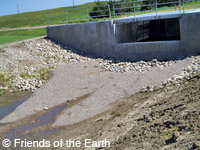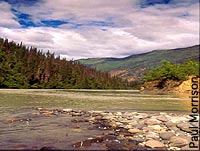
News |
- Passage of Climate Legislation Urged
- Devils Lake Outlet Arguments Heard
- IPCC Report Underscores Urgent Need for Action
- DehCho First Nations Demand 'Conservation First'
- Oil and Gas Sector Ignores Climate Change
- US Supreme Court Global Warming Case
- BC First Nation Adopts Mining Policy
- EU Adopts Energy and Climate Change Strategy
- Suzuki Tour Wraps Up
- China - Economic Boom and Environmental Woes
- $2.5 Million for Lands Planning
- Red River Valley Water Supply Review Continues
| Passage of Climate Legislation Urged | 16 April 07 |
|
"This is a moment of truth for government. We now have a bill that puts us on the path to honouring our Kyoto obligations," said John Bennett, Executive Director of Climate Action Network Canada. "This is government's chance to prove it is taking the climate crisis seriously by respecting the democratic process and implementing this historic bill immediately." When the government introduced Bill C-30 October 2006, it was quickly condemned as inadequate by environmental organizations, opposition Members of Parliament and the public. Under pressure, Prime Minister Harper created a legislative committee to reconsider and rewrite it. The Commons committee co-operated to make major revisions. The renamed Clean Air and Climate Change Act - would require regulations to set absolute caps at "Kyoto levels" (6% below 1990 emission levels) on greenhouse gas emissions from heavy industry, taking effect January 2008. The Bill would also require vehicle fuel consumption regulations to match international best practices. View the March 30, 2007 Climate Action Network press release View the March 30, 2007 Toronto Star article View the March 30, 2007 CTV News article Sources: Climate Action Network, Toronto Star, CTV News
|
|
| Devils Lake Outlet Arguments Heard | 13 April 07 |
 On March 2, 2007, North Dakota's District Court heard arguments in Manitoba's challenge of the North Dakota Department of Health decision to modify the Devils Lake outlet operating permit. On March 2, 2007, North Dakota's District Court heard arguments in Manitoba's challenge of the North Dakota Department of Health decision to modify the Devils Lake outlet operating permit.The legal challenge was filed September 2006 by the Manitoba government, People to Save the Sheyenne River, the Peterson Coulee Outlet Association, and the US National Wildlife Federation. In August 2006, North Dakota's Department of Health modified the Devils Lake operating permit to allow higher levels of sulfates to be discharged from the lake to the Sheyenne River and expanded the time period each year during which the outlet can be operated. The Devils Lake outlet did not operate in 2006 because sulphate levels in the adjacent Sheyenne River were above state guidelines. Raising the allowable limit for sulphate, and extending the operating period, will increase the amount of water discharged from Devils Lake. Water Stewardship Minister Christine Melnick says this increases the risk that foreign biota will be transferred into Manitoba. Manitoba's legal challenge is based on the assertion that North Dakota failed to demonstrate adequate cause for the permit modifications and failed to conduct an anti-degradation review as required for a major permit modification. A decision by the Court regarding Manitoba's appeal is expected by the end of April 2007. View the March 2, 2007 Government of Manitoba press release Source: Government of Manitoba
|
|
| IPCC Report Underscores Urgent Need for Action | 13 April 07 |
 International scientists have concluded that measurable regional effects of climate change are evident on all of earth's continents. This is a finding emphasized by Intergovernmental Panel on Climate Change (IPCC), scientists in their second summary report for 2007 April 6, 2007. International scientists have concluded that measurable regional effects of climate change are evident on all of earth's continents. This is a finding emphasized by Intergovernmental Panel on Climate Change (IPCC), scientists in their second summary report for 2007 April 6, 2007.The IPCC Working Group II report focuses on how global warming is changing life on Earth and impacting ecological processes and people, while identifying species and regions at greatest risk and describing options for limiting risks. Dr. Martin Parry, co-chairman of the team that authored the April 2007 report, made the point that "We're no longer arm-waving with models," he said. "This is empirical information on the ground." "The warnings are clear about the scale of projected changes to the planet," said Bill Hare, report author and visiting scientist at the Potsdam Institute for Climate Impact Research. "Essentially, there's going to be a mass extinction within the next 100 years unless climate change is limited," added Dr. Hare. In Canada, predicted effects include lower water levels in the Great Lake more wildfires and more frequent, violent storms in Atlantic Canada. Wildlife, agriculture, forests and the water supply will all be drastically affected. The report is an even more convincing argument for Canada to address climate change with immediate cuts to greenhouse gas emissions; helping citizens cope with climate induced change that has already and will continue to occur. View April 2007 Working Group II Report, Climate Change 2007: Climate Change Impacts, Adaptation and Vulnerability - Summary for Policymakers (PDF) View more on the April 2007 IPCC report from Manitoba Wildlands View the April 6, 2007 Associated Press article on the CBC website View the New York Times articles: April 5, 2007 & April 6, 2007 View the April 7, 2007 Los Angeles Times article View The Toronto Star articles: April 7, 2007 & April 6, 2007 (Associated Press) Sources: IPCC, New York Times, Los Angeles Times, Toronto Star, CTV News, Vancouver Sun, Associated Press
|
|
| DehCho First Nations Demand 'Conservation First' | 11 April 07 |
 Conservation groups are rallying behind the DehCho First Nations, who are saying the federal government must adopt the DehCho land-use plan before they will proceed with negotiations regarding the proposed Mackenzie Valley Pipeline project. Conservation groups are rallying behind the DehCho First Nations, who are saying the federal government must adopt the DehCho land-use plan before they will proceed with negotiations regarding the proposed Mackenzie Valley Pipeline project."Our position is that without the Land Use Plan, there won't be a pipeline", said DehCho First Nations Grand Chief Herb Norwegian. "Implementing the Land Use Plan is key to unlocking the development potential of our territory and securing a sustainable future for our children." Government of Canada negotiators have stated the Plan places too much emphasis on conservation and will not be approved in its current form. WWF-Canada, Canadian Parks and Wilderness Society (CPAWS), Ducks Unlimited Canada (DUC) and the Canadian Boreal Initiative recently announced their support for the DehCho First Nations Land Use Plan. Under an Interim Measures Agreement signed in 2001, half of the DehCho region - covering 20 million hectares of the Mackenzie watershed - has been protected from development. Grand Chief Norwegian said if the federal government refuses to endorse the land-use plan and tries to go ahead with the pipeline anyway, the DehCho have a legal strategy ready. The DehCho are the largest aboriginal group opposing the massive project and lay claim to land that covers about 40 per cent of the proposed pipeline route. View the April 4, 2007 DehCho First Nations, WWF Canada, CPAWS, Ducks Unlimited Canada & CBI release View the April 4, 2007 Canadian Press article on CBC View the April 05, 2007 Calgary Herald article on Edmonton Journal View the CBI backgrounder, The Real Wealth of the Mackenzie Region (PDF) View a Timeline of the DehCho Land Use Plan (PDF) Sources: Canadian Boreal Initiative, Canadian Press
|
|
| Oil and Gas Sector Ignores Climate Change | 11 April 07 |
 Canada's oil and gas companies are not taking action to mitigate their greenhouse gas emissions, according to a recent report by The Ethical Funds Company. Canada's oil and gas companies are not taking action to mitigate their greenhouse gas emissions, according to a recent report by The Ethical Funds Company.In the research paper, Head in the Oil Sands? Climate Change Risks in Canada's Oil and Gas Sector, Ethical Funds assessed 48 Canadian oil and gas companies and two global leaders on climate change, BP plc and Royal Dutch Shell, as to their management systems, action plans, performance, and transparency. The aim was to determine the extent to which companies are preparing for the future risks presented by climate change. Only four of the 50 companies assessed, including two of the 48 Canadian companies - Shell Canada and Suncor - were found to be responding appropriately, and positioned to function in a more carbon-neutral environment. "We hope the Canadian oil and gas sector will use this report to unite in a process to stabilize emissions, achieve carbon neutrality and, in the decade to come, make the transition to a carbon-free energy system," said Bob Walker, Vice President, Sustainability at The Ethical Funds Company. "Climate change is without a doubt the most significant environmental challenge facing our society today." View the March 13, 2007 Ethical Funds Inc. press release View the Ethical Funds report, Head in the Oil Sands? Climate Change Risks in Canada's Oil and Gas Sector (PDF) View the March 14, 2007 Globe and Mail article Source: Globe and Mail
|
|
| US Supreme Court Global Warming Case | 11 April 07 |
 In one of its most important environmental decisions, the US Supreme Court ruled April 2, 2007 the Environmental Protection Agency (EPA) has the authority under the Clean Air Act to regulate greenhouse gases in vehicle emissions and that greenhouse gases are air pollutants under this law. The court also ruled the agency could not sidestep its authority to regulate greenhouse gases that contribute to global climate change unless it could provide a scientific basis for its refusal. In one of its most important environmental decisions, the US Supreme Court ruled April 2, 2007 the Environmental Protection Agency (EPA) has the authority under the Clean Air Act to regulate greenhouse gases in vehicle emissions and that greenhouse gases are air pollutants under this law. The court also ruled the agency could not sidestep its authority to regulate greenhouse gases that contribute to global climate change unless it could provide a scientific basis for its refusal. The 5 to 4 decision was a strong rebuke to the Bush administration, which has maintained that it does not have the right to regulate carbon dioxide and other heat-trapping gases under the Clean Air Act, and that even if it did, it would not use the authority. The ruling does not force the environmental agency to regulate auto emissions; however, the Clean Air Act itself states that the EPA "shall regulate" any air pollutant "reasonably anticipated" to endanger "public health or welfare," which includes effects upon "climate or weather." The Supreme Court ruling marked the first US high court decision in a case involving global warming. View the April 2, 2007 Associated Press article on International Herald Tribune View the April 2, 2007 Associated Press article on New York Times View the April 2, 2007 New York Times article View the April 2, 2007 Sierra Club US press release View the April 2, 2007 Reuters article on Yahoo News View the US Supreme Court Decision, Environmental Defense et al. vs. Duke Energy Corp et al., April 2, 2007 (PDF) View the US Supreme Court Decision, Massachusettes et al. vs. Environmental Protection Agency et al., April 2, 2007 (PDF) Sources: Associated Press, New York Times, Reuters, Sierra Club US
|
|
| BC First Nation Adopts Mining Policy | 05 April 07 |
 The Taku River Tlingit First Nation (TRTFN) released its TRTFN Mining Policy March 13, 2007. The 350-member First Nation is spelling out what it calls the "rules of engagement" for companies looking to develop metal and mineral resources in a 40,000-square kilometers territory that encompasses Atlin Lake and extends to the Yukon border. The Taku River Tlingit First Nation (TRTFN) released its TRTFN Mining Policy March 13, 2007. The 350-member First Nation is spelling out what it calls the "rules of engagement" for companies looking to develop metal and mineral resources in a 40,000-square kilometers territory that encompasses Atlin Lake and extends to the Yukon border."Concisely and clearly, it spells out our determination to protect our land and aquatic resources while, at the same time, providing an accessible and easy-to-understand guide for mining companies who would like to do business with us" said TRTFN spokesperson, Sandra Jack, "This is not a Policy that gives the go ahead to every mining project. The protection of our community and territory come first. When the ore runs out or the commodity boom fizzles on the stock market, the Tlingit people will still be here. Responsible companies will respect that." The 17-page policy sets out a prioritized system for preliminary evaluation of a particular proposal as well as the decisions relating to exploration activities, environmental assessments and impacts and benefits agreements. All aspects of the policy are directly linked to TRTFN's Aboriginal rights. In addition, the new policy also stipulates that TRTFN will remain vigilant when it comes to protecting its land, wildlife and aquatic resources. "The voices of our Elders are woven into our new policy," Jack says. "The policy is really an extension of their love and great respect for the land, rivers, resources and wildlife." View the March 13, 2007 First Perspective article View the March 13, 2007 Vancouver Sun article (DOC) Sources: First Perspective, Vancouver Sun
|
|
| EU Adopts Energy and Climate Change Strategy | 05 April 07 |
 Following a two-day summit in Brussels in early March 2007, the European Union adopted a bold new strategy for action on energy policy and climate change. European Commission President Jose Manuel Barroso called it "the most ambitious package ever agreed by any commission or any group of countries on energy security and climate protection." Following a two-day summit in Brussels in early March 2007, the European Union adopted a bold new strategy for action on energy policy and climate change. European Commission President Jose Manuel Barroso called it "the most ambitious package ever agreed by any commission or any group of countries on energy security and climate protection."The deal sets binding targets for cutting greenhouse gas emissions, developing renewable energy sources, promoting energy efficiency and using biofuels. The 27 EU states will cut carbon dioxide emissions by 20% from 1990 levels by 2020, (beyond the targets committed to in the Kyoto Protocol). Each state will also contribute to meeting a 20% boost overall in renewable energy from sources such as wind, solar and hydroelectric power by 2020. It is thought the EU could offer to extend its 20% target for emissions cuts to 30% if other heavy polluters like the US, China and India come on board. German Chancellor Angela Merkel, who holds the presidency of both the EU and the Group of Eight industrialized nations, will present the EU's plans to President Bush and other G-8 leaders at the June 2007 summit. View the March 9, 2007 BBC News article View the March 9, 2007 Reuters article View the March 9, 2007 Associated Press article in the Washington Post website Sources: BBC News, Reuters, Associated Press
|
|
| Suzuki Tour Wraps Up | 02 April 07 |
 Dr. David Suzuki capped off his 50 city "If you were Prime Minister..." tour by arriving in Victoria at Terry Fox's statue at Mile Zero and then holding a grand finale in Ottawa March 2nd at the Museum of Civilization. Dr. David Suzuki capped off his 50 city "If you were Prime Minister..." tour by arriving in Victoria at Terry Fox's statue at Mile Zero and then holding a grand finale in Ottawa March 2nd at the Museum of Civilization.During the non-partisan tour, Dr. Suzuki spoke to thousands of Canadians in every province to find out what Canadians think we need to do for the environment. He says crowds in 42 different venues had the same concerns and the tour convinced him most Canadians are willing to pay more out of their own pockets to fight climate change, provided big industries are forced to do the same. "Maybe we're speaking to the converted, in which case there's a hell of a lot of converted, but certainly the people we encountered are ready to pay higher prices and to sacrifice, because they see this is a great danger." Suzuki also warned that the flip side of the economic outlook - the price of not acting on climate change - is a lot more frightening than the cost of transforming the economy into one that uses less carbon fuel. Suzuki also spoke alongside former U.S. vice-president Al Gore at Montreal's Palais des Congres March 22nd to 5,000 mostly young Montrealers eager to hear calls for massive global action to avoid the potentially catastrophic effects of global warming. Suzuki noted the environment has been at the top of the public's agenda before and challenged young people to keep it there. View the February 28, 2007 David Suzuki Foundation press release View the March 2, 2007 Ottawa Citizen article View the March 4, 2007 CanWest News Service article View the March 23, 2007 Ottawa Citizen article View the David Suzuki Foundation Tour website, and submit your vote for the environment View previous Manitoba Wildlands news items: February 22, January 24 & February 9, 2007 Sources: David Suzuki Foundation, Ottawa Citizen, CanWest News Service
|
|
| China - Economic Boom and Environmental Woes | 02 April 07 |
 China's economy is booming, with an annual growth rate of over 10%. But the more cheap Chinese goods the world's consumers buy, the higher the environmental price the world will pay for China's economic miracle. Five of the 10 most polluted cities are in China. More than two-thirds of Chinese rivers and lakes are turning into sewers and more than 360 million Chinese people have lost access to clean drinking water. China's economy is booming, with an annual growth rate of over 10%. But the more cheap Chinese goods the world's consumers buy, the higher the environmental price the world will pay for China's economic miracle. Five of the 10 most polluted cities are in China. More than two-thirds of Chinese rivers and lakes are turning into sewers and more than 360 million Chinese people have lost access to clean drinking water. China has installed wind power and Beijing promotes renewable energies, but over two-thirds of China's electricity requirements are met by burning coal, with more than 500 new coal power plants planned. The country recently released a national climate change plan. Climate researchers are increasingly concerned about the pollution China is spreading across the planet, as the contry is already the world's second-biggest producer of greenhouse gases after the United States and will now surpass the US sooner than expected. China's pollution is drifting over Europe, bringing a brownish mass of ozone, dust and soot. Pollution from its coal-fired power plants, smelters and chemical factories, as well as from tailpipes of Chinese diesel-powered cars and trucks is also making its way to the shores of western North America. View the February 1, 2007 Spiegel Online International article View the November 8, 2005 Spiegel Online International article View the February 1, 2007 Worldwatch Institute article View the February 6, 2007 Worldwatch Institute article View the February 8, 2007 Worldwatch Institute article View the February 22, 2007 Worldwatch Institute article Sources: Spiegel Online International, Worldwatch Institute
|
|
| $2.5 Million for Lands Planning | 28 March 07 |
 The Manitoba Government has announced a $2.5-million transfer agreement signed with the Wabanong Nakaygum Okimawin (WNO) Council of Chiefs. The funds will be released in five equal payments over five years and the first payment of $500,000 has been made to the WNO, the first of five payments between now and 2011. The announcement of this initial payment for up to 16 east side First Nations was first made August 2006. The Manitoba Government has announced a $2.5-million transfer agreement signed with the Wabanong Nakaygum Okimawin (WNO) Council of Chiefs. The funds will be released in five equal payments over five years and the first payment of $500,000 has been made to the WNO, the first of five payments between now and 2011. The announcement of this initial payment for up to 16 east side First Nations was first made August 2006.First Nations on the east side of Lake Winnipeg can apply to WNO for these funds to carry out individual land-use plans. No details were provided as to when First Nations would be able to apply or what application criteria or process will be followed. Minister Struthers highlighted the importance of the activities to be funded, stating that "Traditional land-use planning will assist First Nations and Aboriginal Peoples plan how to best use lands and resources within their nations." The goal of WNO is to develop a broad-area plan for the east side of Lake Winnipeg. The plan would make the protection of the environment and boreal forest in the region a priority. View the March 23, 2007 Government of Manitoba press release View past Manitoba Wildlands news items: February 22, 2007 - East Side Planning Funds Not Released August 17, 2006 - Half Million for East Side Lands Planning Visit Manitoba Wildlands' webpage on the Wabanong Nakaygum Okimawin (WNO) Source: Government of Manitoba
|
|
| Red River Valley Water Supply Review Continues | 28 March 07 |
 The Supplemental Draft Environmental Impact Statement (DEIS) for the Red River Valley Water Supply Project was released January 31, 2007. The Supplemental Draft Environmental Impact Statement (DEIS) for the Red River Valley Water Supply Project was released January 31, 2007. The Supplemental DEIS contains revisions to the Draft Environmental Impact Statement (DEIS) of December 30, 2005, and incorporates comments related to environmental issues received as part of the public review process for the DEIS. The report is the latest in a series of reports intended to evaluate alternative ways to meet water quality and quantity needs of North Dakota's Red River Valley. The project has been controversial because several options involve plans similar to the Garrison Diversion project and would move water between watershed basins - from the Missouri River into the Red River. To date, North Dakota continues to ignore assertions by concerned citizens, environmental groups, as well as the Government of Manitoba that in-basin solutions to meet future water supply needs in the Red River Valley are the only acceptable options. The question of how Aboriginal rights in the US and Canada will be upheld and accommodated has not been adequately addressed in the review process. North Dakota also continues to ignore calls for the project to be referred to the International Joint Commission. Under The Boundary Waters Treaty of 1909, both Canada and the US must make such a request in order for the IJC to intervene in the matter. The public comment period for the Supplemental DEIS closed March 26, 2007. View the Supplemental Draft Environmental Impact Statement for the Red River Valley Water Supply Project (PDF) View previous Manitoba Wildlands' news items: April 21, 2006 - Controversial Water Project Comments Extended March 1, 2006 - Manitoba/US Water Conflicts Escalate View Manitoba Wildlands' information on Transboundary Water Projects Sources: US Bureau of Reclamation, Manitoba Wildlands
|
|


 RSS Feeds:
RSS Feeds: